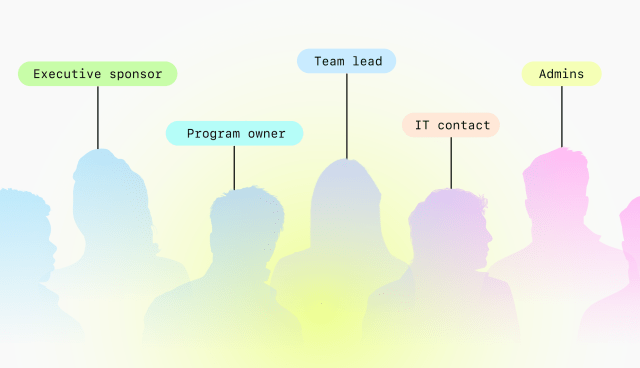AI in action
– 11 min read
Driving marketing transformation with generative AI: A recap from Cannes Lions

Generative AI is already redefining marketing as we know it. Using this emerging technology, marketing teams at the world’s biggest brands are liberating themselves from the minutiae of process-driven tasks and enhancing their decision-making so they can focus on creativity and developing strategy that delivers meaningful business outcomes. With that shift comes the responsibility of navigating the current state of generative AI and figuring out how to best use its capabilities to drive real business impact.
During a Cannes Lions Marketing Leadership Panel, Writer co-founder and CEO May Habib interviewed three marketing and brand leaders about their successful strategies for integrating generative AI within their organizations and how they’re using it to reshape their marketing strategies:
- Drew Panayiotou, Global chief marketing officer, Pfizer
- Lindsay Barrett, Global VP of data-driven marketing, Mars
- Matt Fantazier, Head of integrated media, Kenvue
Here are the three major takeaways from the discussion. You can watch the full recording of the panel at the end of the article.
- Generative AI is transforming marketing roles by automating routine tasks, allowing for a focus on creativity and strategic initiatives.
- Demonstrating AI’s efficiency — such as reducing content approval processes from weeks to minutes — helps gain organizational buy-in.
- AI acts as a creativity multiplier, freeing marketers from mundane tasks and enabling them to pursue more creative and impactful work.
- AI has practical uses in marketing, like simplifying the process of creating content for different platforms and boosting both productivity and creativity.
- Challenges in AI adoption highlight the need for user-friendly applications and continuous technology improvement to meet marketers’ needs.
Takeaway 1: Generative AI is reinventing the marketing function
The impact of generative AI goes far beyond improving operational efficiency. It’s reshaping the very essence of marketing as a business function. We’re seeing a real-time shift from traditional, process-driven strategies to more dynamic, creative, and efficient approaches.
Drew Panayiotou started the conversation by speaking directly to how this new AI-driven era of creativity and strategic thinking is affecting his role as CMO at global pharmaceutical company, Pfizer.
“I think [generative AI] completely changes the role of the CMO,” Panayiotou said. “You don’t have to spend so much time worrying about perfection, and you spend more time putting more stimulus out in the world.”
When marketers can partially automate process-driven tasks with generative AI, it allows them to devote more time to creativity. “All of a sudden it’s like, I don’t need to choose between one or two vectors. I need to have a brief, and then I gotta move that brief out, and then I have to optimize content and build the relationships with my customers that I need to build,” Panayiotou said.
This complete rethink of the marketing organization extends to its value within the business. Marketing leaders can shift from reactively proving their department’s tangible value to proactively showcasing their critical role in driving business growth.
“We always talk about the CFO and like, ‘What do marketers really do?’ I think it gives us a chance to finally say, ‘Marketing is that growth engine,’” Panayiotou said. “And so I am totally jazzed because I think all the things that we’re talking about today allow us to grow the business differently and I think, make marketing that value driver.”
Confronting AI adoption hurdles
While AI clearly enhances efficiency and facilitates brand growth, integrating these tools into marketing processes presents its own set of challenges.
Habib mentioned the three mountains of AI scale: app quality, user adoption, and value realization. The vast majority of the market is still climbing that first mountain of app quality, but Panayiotou’s team has already built pilots and POCs to establish a strong foundation so it can summit all three of those mountains.
“There’s no question that AI is faster, better, cheaper,” Panayiotou said. “And we have the metrics on that. We have pilots with 72% reduction in marketing burden, making content savings 42%. So the numbers were there. But one of the most important KPIs that we focused on was the net promoter score of the marketing organization, and it wasn’t good. And I was talking about this with Adobe and of course they were proud of their platform, as they should be. We have to make the versioning of the marketing tools easy to use because reducing the marketing burden on one piece of the process doesn’t make their life necessarily easier unless you look at it from an end-to-end perspective. And so I think for us it’s really been getting the use cases out there, cycling through the work with the marketing teams, understanding and being user-centric.”
It’s key that businesses place user experience at the forefront of every POC and AI transformation effort. As demonstrated by Panayiotou’s team, making sure that AI tools are relevant, user-friendly, and boost efficiency is crucial for their successful integration and widespread adoption within an organization.
Takeaway 2: Effective AI integration requires cross-functional collaboration and buy-in
The ability to highlight AI’s tangible advantages and how those benefits affect efficiency is crucial to getting organizational buy-in. This kind of approach helps build widespread cross-organizational support and excitement for adopting AI technologies, which also positively impacts employee satisfaction.
Lindsay Barrett explained the different ways her team views efficiency at global food and pet product manufacturer, Mars. Efficiency isn’t measured only from a cost-savings perspective, but from a time-saved point of view.
“We want to give our associates some time back in their day,” Barnett said. “I think associate well-being is massive at Mars and this actually is a real opportunity for us not to fill those hours with more work, but to give people sometimes a bit of time back for their own well being, but maybe pivot them into some more creative spaces.”
Generative AI’s efficiency can only be realized with executive buy-in. High-level leadership involvement not only accelerates the adoption of new technologies but also helps in overcoming resistance from employees who might be skeptical about AI. Generative AI implementation usually involves four key roles:
- Executive sponsor: The executive sponsor drives the overall AI strategy, secures resources, and provides alignment across the organization, focusing on demonstrating the ROI of AI initiatives.
- AI program director: This role manages the AI rollout and ongoing program management, coordinating with various teams and communicating progress to the executive sponsor.
- Technical manager/IT admin: Involved early in the process, the IT admin addresses security concerns, manages user accounts, and oversees integrations.
- Team leads: Team leads implement the AI strategy at the operational level, developing best practices and collecting user feedback to refine AI applications.
Matt Fantazier spoke about how his team at consumer health company Kenvue works together with the tech team, which builds a stronger connection at the organizational level. To drive things forward, he said, you need to be able to show leaders what’s around the corner.
Evoking a famous sentiment shared by Henry Ford, Fantazier shared that, “If I asked people what they wanted, they’d say a faster horse. You have to be able to show them what is possible with this and not just fall into the trap of incrementality. It’s how are we going to operate differently as an organization and drive that top-down. And you have to be engaged. We have to have leadership engagement from visioning all the way through execution. When you don’t have that, teams revert to old ways of working and you don’t create progress. So it is critical that it is central, that it’s connected and it’s really just part of the fabric of how we do business.”
When leaders are enthusiastic and supportive of AI technologies, this attitude permeates throughout the organization, fostering a culture of innovation and openness to change. At Mars, Barrett said their global general counsel is a strong advocate for AI, which has made organizational adoption a much smoother process. Senior leaders at Mars also meet monthly to address and resolve any operational challenges.
“Our chief general counsel, our chief information officer, our chief branded experience officer all sit there and we meet once a month and we talk through what are the sort of swamp pits? Where are we getting stuck? Where are we bashing our head against the wall? And I think that’s really useful in terms of being able to unblock some of those challenges for the teams who are actually utilizing it.”
Takeaway 3: Generative AI acts as a creativity multiplier, freeing up marketers to perform more creative work
AI’s role as a creativity multiplier enables marketers to focus on more high-value work. Some of the most popular generative AI use cases involve creating content, analyzing data, and providing governance across various business functions. While generative AI is adept at automating tasks, it’s important to remember that there’s a delicate balance to be struck between automation and human ingenuity in crafting marketing strategies.
When generative AI allows marketers the time to be creative, that ultimately is what connects brands with consumers. Barrett’s team got right to work identifying their own use cases for generative AI, turning a three-week process into a three-minute one in one such case.
“We identified some obvious use cases, like content creation. But content approval was massive for us,” Barrett said. “In some of our markets, we were sending up to 600 assets a month to legal and regulatory, and it was taking up to three weeks of manual review with a 25% rejection rate of those assets. So we instantly knew the legal team had to be a massive part, not just of standing back and approving AI in the business, but we built a use case for them. We built a use case that meant the team that they ran could suddenly take a three-week process and turn it into a three-minute process.”
Barrett further spoke to how her team didn’t waste any time theorizing use cases, but executed them quickly.
“We literally took the tools and the apps in and went, right, you create the PDP pages, get in here, and let’s do a seasonal update. And we did it live in the room with them. And I think one of the most powerful moments was in one of the workshops we ran, we said, ‘All right, let’s upload a PDF of our brand guidelines now. Let’s run and test the 10,000 PDP pages we’ve got.’ And in three seconds we could identify 65% of them are not brand compliant. And the team just went, whoa.”
The future of AI depends on an openness and a willingness to experiment with AI. While there are common concerns about AI replacing jobs, as Fantazier noted, it’s those who learn how to work alongside AI who will advance.
Panayiotou added to that point: “It’s the next generation of marketers that embraces how AI tools work, that will be the most successful. And it doesn’t have to deal with age. Sometimes when we see the next generation, we think everyone’s 20. It will be those that literally live and breathe and play with AI, and you gotta play with AI. And we have to have our legal teams allow us to play with AI. And if you play with AI, you will fall in love with AI and it will make your craft so much better.”
AI may not be the end-all be-all solution. But the time it gives back to marketing leaders is what will ultimately allow brands to execute more creative and innovative strategies.
“AI allows for the space for our marketers to come up with brilliant ideas. Creativity, that’s ultimately what breaks through with consumers,” Fantazier said. “But how can we use AI to actually enhance the effectiveness? And creativity is sort of the next horizon. And measuring those metrics beyond just cycle time, I think is what’s really exciting, what we’re going to see start to emerge next.”
To hear more insights from our conversation with global marketing leaders, watch the recording of the panel from Cannes Lions. You’ll learn more about how AI is transforming marketing functions, how to get org-wide buy-in for AI tools, and real-life use cases for generative AI that drive meaningful business impact.






